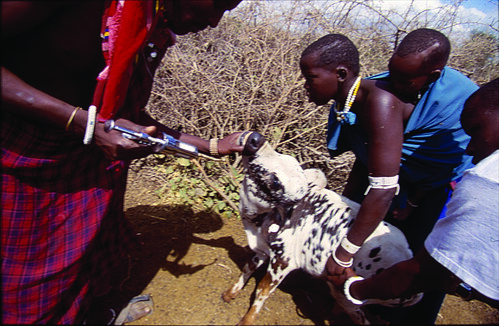 New project launched to investigate how immunity develops in cattle to fatal diseases caused by different strains of tick-borne parasites
New project launched to investigate how immunity develops in cattle to fatal diseases caused by different strains of tick-borne parasites
More than 1 in 5 people in sub-Saharan Africa live below the poverty line. Many of these people live in rural communities heavily dependent on livestock for their livelihoods. One of the most important diseases of cattle in this region is East Coast fever, a lethal infection of cattle caused by the tick-borne parasite Theileria parva. This disease afflicts cattle populations in 16 countries across eastern, central and southern Africa and is the most economically important cattle disease in 11 of these countries. Losses due to East Coast fever exceed US$300 million annually. Imported high-yielding breeds of cattle, which are increasingly being used to satisfy increasing demands for milk in this region, are particularly susceptible to this disease.
Although East Coast fever can be controlled by treating infected animals with anti-parasitic drugs and by regularly spraying or dipping animals with anti-tick chemicals, these methods are difficult to apply and costly for poor livestock keepers. Vaccination offers a more sustainable means of controlling the disease.
Cattle can be immunized against the disease by infecting them with live parasites while simultaneously treating the animals with long-acting antibiotics. Because several strains of the parasite exist in the field, this vaccination comprises a mixture of strains. A vaccine cocktail mixing three parasite strains is being used successfully in some endemic countries, but applying this so-called ‘live vaccine’ remains hindered by difficulties in maintaining the quality of the vaccine material and in finding ways to distribute the vaccine, which needs to be kept cold, cost-effectively to widely dispersed cattle herders. In addition, it remains uncertain whether the current mix of parasite strains in the vaccine is optimal for obtaining robust immunity.
Recent studies of East Coast fever have shown that the so-called ‘protective’ proteins of the causative parasite—that is, the antigenic molecules that are recognized by the T lymphocytes of the bovine immune system and thus help animals fight development of disease—vary among the different strains of the parasite that exist in the field. This project will build on these advances to investigate the nature and extent of variability in these antigens between parasite strains. This knowledge will help scientists understand the factors that determine which parasite strains induce protective immune responses in animals that have been vaccinated.
Results of the project should provide methods for maintaining high quality of the current live vaccine and identifying parasite strains that could be incorporated into an improved second-generation live vaccine. The information should also help researchers design new, genetically engineered, vaccines, which comprise not whole parasites but rather antigenic molecules of the parasite—and thus are safer, cheaper and easier to distribute than the current live vaccine.
‘This is an important project for us,’ said Philip Toye, a vaccine developer from International livestock Research Institute (ILRI). ‘The information we expect to generate will greatly increase our understanding of the current live vaccine that is being used to protect animals against East Coast fever. We can use this information to get this vaccine into wider use in the region.’
This project is being conducted jointly by scientific groups at the universities of Edinburgh and Glasgow, in Scotland, and at ILRI, in Nairobi. The project is part of a new initiative called Combating Infectious Diseases of Livestock in Developing Countries funded by the UK’s Biotechnology and Biological Services Research Council, the UK Department for International Development and the Scottish Government. ILRI’s research in this area is also supported by members of the Consultative Group on International Agricultural Research.
